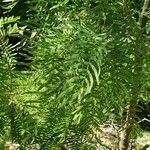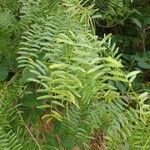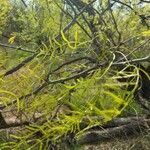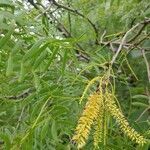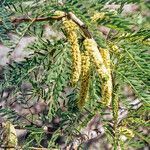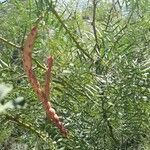Tree or shrub to 10 m tall; branchlets glabrous; spines solitary, 20–60 mm long. Leaves deciduous, green, glabrous; petiole 30–85 mm long; pinnae 1-(2)-jugate, 7.5–18 cm long; leaflets 8–16-jugate, narrowly oblong, acute, mucronate, relatively rigid, coriaceous, lying flat when dry, (15–) 25–45 (–50) mm long, (2–) 2.5–4.5 (–5) mm wide, 7–13 (–15) times as long as wide; internodes of the pinnae axes (5–) 8–14 mm long. Racemes 7–8 cm long, mostly longer than the leaves. Calyx ciliolate. Pod straight or slightly curved, margins regularly constricted between the seeds, 8–19 cm long, 8–10 mm wide, straw-coloured with reddish purple markings or almost entirely reddish purple, glabrous.
Shrub or tree to 10 m high armed at the nodes with paired or solitary straight spines 0.5-3 cm long. Leaves bipinnate; with 1-2 pinnae pairs; leaflets 7-22 pairs per pinna, 1-6 cm long, 1-4 mm wide, widely spaced on the rhachilla, the intervals wider than the width of the leaflets, venation fairly conspicuous, glabrous. Inflorescence an axillary spike; flowers sessile, yellow. Ovary densely pilose. Pod straight or almost so, 10-22 cm long, ±8 mm in diameter, margins not or scarcely constricted, valves becoming woody, with a fibrous exocarp, beaked apically.
Glabrous shrub or tree, up to 10 m tall, with straight spines in pairs or solitary at nodes. Leaves twice pinnate, with 1 or 2 pairs of pinnae, leaflets 10-25 mm long, widely spaced, glabrous. Flowers in axillary spikes, yellow. Pod ± straight, becoming woody, yellowish to purplish, margins slightly constricted between seeds.
Multistemmed, armed shrub or small tree to 10 m, glabrous; spines paired. Leaves bipinnate. Flowers in cylindrical spikes, yellow. Pods slender, ± straight, woody, yellowish to purplish, constricted between seeds, indehiscent.
See Prosopis glandulosa Torr. var. glandulosa
